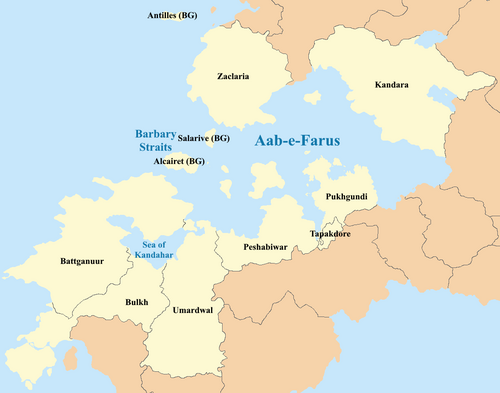Middle seas region: Difference between revisions
mNo edit summary Tag: 2017 source edit |
mNo edit summary Tag: 2017 source edit |
||
| Line 1: | Line 1: | ||
{{stub}} | {{stub}} | ||
The Middle seas region, also known as the Middle seas, or the Audonio-Alshari Intercontinental Cultural and Economic Interface Zone (AAICEIZ | [[File:Middle_seas_region_political_map.png|500px|right|Map of the Middle seas region]] | ||
The Middle seas region, also known as the Middle seas, or the Audonio-Alshari Intercontinental Cultural and Economic Interface Zone (AAICEIZ, pronounced eye-kayz), is the areas of eastern [[Audonia]] (eastern [[Audonia#Siphost|Siphost]] and [[Audonia#Daria|Daria]]) and western [[Alshar]] around the [[Aab-e-Farus]] and the [[Sea of Kandahar]]. It is so named because of the two seas it contains surrounded by the continental landmasses of [[Audonia]] and [[Alshar]], the [[Aab-e-Farus]] and the [[Sea of Kandahar]]. | |||
The Middle Seas region does not have legal status but is more of a cultural and economic generalization for the peoples and nations who are in close proximity to each other and are the typical trade partners and political allies or rivals of the other nations in the region. | |||
Throughout history, peoples, cultures, religions, and languages were constantly intermixing in the region. They were forced together through external forces like the [[Oduniyyad Caliphate]] and the [[Burgoignesc colonial empire]]. Today the nations of the Middle Seas region are totally sovereign and independent of each other, but they share some aspects in common. Many of them, as a vestige of the [[Burgoignesc colonial empire]], use the [[Burgoignesc language]] as their language of business and international politics. Some of them use currency pegged to the [[Taler#Pegged_currencies|Taler]]. And almost all have minority Christian populations dating back to the proselytization of the [[Bergendii]]. | Throughout history, peoples, cultures, religions, and languages were constantly intermixing in the region. They were forced together through external forces like the [[Oduniyyad Caliphate]] and the [[Burgoignesc colonial empire]]. Today the nations of the Middle Seas region are totally sovereign and independent of each other, but they share some aspects in common. Many of them, as a vestige of the [[Burgoignesc colonial empire]], use the [[Burgoignesc language]] as their language of business and international politics. Some of them use currency pegged to the [[Taler#Pegged_currencies|Taler]]. And almost all have minority Christian populations dating back to the proselytization of the [[Bergendii]]. | ||
Revision as of 15:34, 15 April 2023
| This article is a stub. You can help IxWiki by expanding it. |

The Middle seas region, also known as the Middle seas, or the Audonio-Alshari Intercontinental Cultural and Economic Interface Zone (AAICEIZ, pronounced eye-kayz), is the areas of eastern Audonia (eastern Siphost and Daria) and western Alshar around the Aab-e-Farus and the Sea of Kandahar. It is so named because of the two seas it contains surrounded by the continental landmasses of Audonia and Alshar, the Aab-e-Farus and the Sea of Kandahar.
The Middle Seas region does not have legal status but is more of a cultural and economic generalization for the peoples and nations who are in close proximity to each other and are the typical trade partners and political allies or rivals of the other nations in the region.
Throughout history, peoples, cultures, religions, and languages were constantly intermixing in the region. They were forced together through external forces like the Oduniyyad Caliphate and the Burgoignesc colonial empire. Today the nations of the Middle Seas region are totally sovereign and independent of each other, but they share some aspects in common. Many of them, as a vestige of the Burgoignesc colonial empire, use the Burgoignesc language as their language of business and international politics. Some of them use currency pegged to the Taler. And almost all have minority Christian populations dating back to the proselytization of the Bergendii.
In Alshar it includes the nations and territories of Pursat, Kandara, Tapakdore, Peshabiwar, Pukhgundi, and the Burgoignesc island of Antilles. In Audonia it includes the nations and territories of Bulkh, Umardwal, Zaclaria, and the Burgoignesc islands of Chaukhira and Salarive.